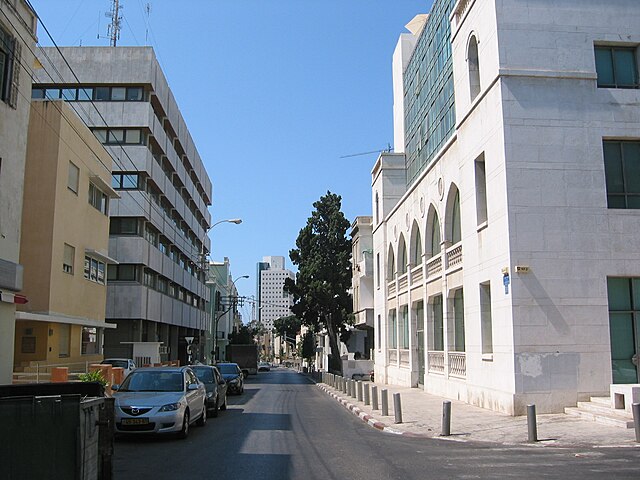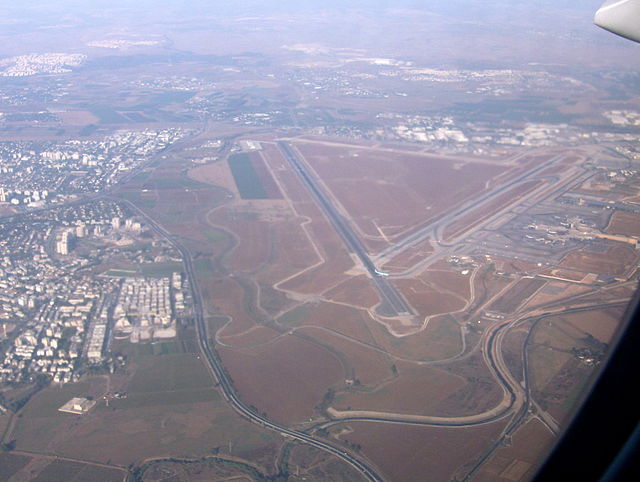Gush Dan
Metropolitan area in Israel From Wikipedia, the free encyclopedia
Metropolitan area in Israel From Wikipedia, the free encyclopedia
Gush Dan (Hebrew: גּוּשׁ דָּן, lit. 'Dan bloc') or Tel Aviv metropolitan area is a conurbation in Israel, located along the country's Mediterranean coastline. There is no single formal definition of Gush Dan, though the term is in frequent use by both governmental bodies and the general public. It ranges from combining Tel Aviv with cities that form an urban continuum with it, to the entire areas from both the Tel Aviv District and the Central District, or sometimes the whole Metropolitan Area of Tel Aviv,[2] which includes a small part of the Southern District as well. Gush Dan is the largest conurbation and metropolitan area in Israel and the center of Israel's financial and High technology sector. The metropolitan area having an estimated population of 4,156,900 residents, 89% of whom are Israeli Jews.
Gush Dan
| |
|---|---|
 | |
| Nickname: Dan Bloc (Gush Dan in Hebrew) | |
 | |
| Coordinates: 32°2′N 34°46′E | |
| Country | |
| Metropolitan Area | Gush Dan |
| Area | |
| • Total | 1,516 km2 (585 sq mi) |
| Population | |
| • Total | 4,156,900 44% of Israel's population |
| • Metro density | 2,291/km2 (5,930/sq mi) |
| Israeli Jews: 89.2% Israeli Arabs: 5.2% Others: 5.6% | |
| GDP | |
| • Total | US$310 billion 59% of Israel's GDP (2022) |
| Time zone | UTC+2 (IST) |
| • Summer (DST) | UTC+3 (IDT) |
| Postal code | 61999 |
| Area code | +972 (Israel) |
The name Gush Dan means "Dan Bloc", and is so named because the area was the territory of the tribe of Dan in the ancient Kingdom of Israel. According to the biblical narrative, the tribe had originally tried to settle in the central coastal area of Canaan, but enmity with the Philistines, who had already settled there, caused it to be able to camp only in the hill country overlooking the Sorek Valley. The camp location became known as Mahaneh Dan ("Camps of Dan"). The region that they attempted to settle included the area as far north as Joppa and as far south as Shephelah in the area of Timnah. As a result of the pressure from the Philistines, the tribe abandoned hopes of settling near the central coast and instead migrated to the north of the country. After conquering Laish, the tribe refounded it as its capital and renamed it Dan. In remembrance of the original territory assignments, the coastal region is referred to as Gush Dan. The modern city of Tel Aviv was founded in 1909 as a suburb of the Arab-majority coastal city of Jaffa.[8]
The city of Tel Aviv grew rapidly in the ensuing decades by Jewish immigration from Europe, with its population reaching 150,000 in 1934, and 230,000 when Israel gained its independence in 1948. Before the establishment of Israel, other towns in the Gush Dan were founded as well, such as Petah Tikva in 1878, Rishon LeZion in 1882, Ness Ziona in 1883, Rehovot in 1890, and most other Gush Dan cities were established before 1948.
In 1947, the Jewish population of the Gush Dan was nearly 400,000 and was the majority of the Jewish population of Mandatory Palestine. As such, almost all of it was included in the Jewish state proposed by the 1947 United Nations Partition Plan for Palestine. After the 1948 Arab–Israeli War, the Arab population of the region, which had been nearly 150,000 before the war,[8] was reduced to around 10,000. They were quickly replaced by a larger number of Jews fleeing from postwar Europe and persecution in Arab countries.
However, many new immigrants did not then come to Tel Aviv. In the 1950s, towns were built on the edges of the Gush Dan, including Ashdod, Rosh HaAyin and Yavne. The nation's sole port was then located in the northern city of Haifa and its evolving metropolitan area, making that city at least as important as Tel Aviv. The new government was then trying to disperse the nation's population to the periphery and discouraged settlement in the already-populated Gush Dan. That slowed the growth of the Gush Dan, but the area still more than doubled in population within 20 years of the establishment of Israel. The opening of the Port of Ashdod in the southern Gush Dan also increased the area's importance, with the importance of Haifa diminishing and that of Tel Aviv increasing because of its proximity. Tel Aviv itself witnessed population decreases in the 1970s and 1980s, when outer regions of the Gush Dan with lower costs of living absorbed many of the people who had left Tel Aviv.
Only in the 1990s, with the immigration of more than 1 million Jews from former Soviet Republics, 40,000 Ethiopian Jews, and many others to Israel, as well as a boom in the religious population, would Tel Aviv begin to grow again. The demand for housing increased dramatically, with new cities such as Modiin and El'ad being built, and cities like Ashdod more than doubling in population, from 83,000 in 1990, to 175,000 in 2000. In the 2000s, the area continued to grow, attracting many immigrants from the Haifa metropolitan area. With a population of 4,052,200 people as of 2019,[9] Gush Dan is home to the commercial, economical, cultural, and industrial center of Israel.[10]
The Tel Aviv urban conurbation, stretching from Netanya to Ashdod, concentrates the largest Jewish population globally, nearing 3.9 million Jews. This figure significantly surpasses the Jewish population of the New York metropolitan area, which ranks second with 2.1 million Jews.[11] Despite some successes in ongoing attempts by the Israeli government to encourage migration to the Galilee and the Negev, Gush Dan retains its position as the heart of Israel.
Population in cities as of the end of 2021:[12]
Israel Central Bureau of Statistics divides the Tel Aviv metropolitan area into four:
| Metropolitan ring | Localities | Population (EOY 2018 estimate) | Population density (per km²) |
Annual Population growth rate | |||
|---|---|---|---|---|---|---|---|
| Total | Jews and others1 | Thereof: Jews | Arabs | ||||
| Core2 | 1 | 451,500 | 431,100 | 407,200 | 20,400 | 8,718.6 | 1.7% |
| Inner Ring3 | 13 | 975,600 | 973,700 | 911,900 | 2,000 | 8,097 | 1.4% |
| Northern Section | 4 | 144,300 | 144,100 | 138,800 | 200 | 3,327.4 | 1.3% |
| Eastern Section | 5 | 495,100 | 494,400 | 479,600 | 700 | 12,394.3 | 1.9% |
| Southern Section | 4 | 336,300 | 335,200 | 293,500 | 1,100 | 9,042.2 | 0.6% |
| Middle Ring4 | 31 | 1,219,800 | 1,177,300 | 1,108,100 | 42,500 | 4,157.4 | 1.6% |
| Northern Section | 6 | 239,500 | 239,200 | 232,300 | 300 | 4,567.4 | 1.3% |
| Eastern Section | 8 | 325,700 | 325,300 | 304,400 | 400 | 4,558.6 | 1.7% |
| Southern Section | 17 | 654,500 | 612,800 | 571,500 | 41,800 | 3,861.5 | 1.7% |
| Outer Ring5 | 258 | 1,338,000 | 1,200,200 | 1,140,700 | 137,800 | 1,052.9 | 2% |
| Northern Section | 97 | 497,100 | 397,300 | 375,100 | 99,800 | 1,284.9 | 1.3% |
| Eastern Section | 47 | 294,700 | 258,000 | 254,200 | 36,700 | 1,056.4 | 3.3% |
| Southern Section | 91 | 453,300 | 452,600 | 424,200 | 700 | 877.3 | 1.4% |
| Judea and Samaria Section6 | 23 | 93,000 | 92,300 | 87,200 | 600 | – | 4.3% |
| Total | 303 | 3,984,900 | 3,782,300 | 3,567,900 | 202,700 | 2,361.4 | 1.7% |














The Dan Bus Company is primarily focused on serving the Gush Dan, although it is being replaced by the Kavim company in many of the Gush Dan's cities. Much of Israel's national highway network feeds into the area, such as Highway 1, Highway 2, Highway 4, and Highway 5. Gush Dan is also served by the local Ayalon Highway. Israel Railways, the state owned, national rail network provider, also feeds most traffic into or within the Gush Dan region. The Tel Aviv Light Rail is also a major feature in the regions transport, as well as the high speed service to Jerusalem. Two airports are located in the Gush Dan; Sde Dov Airport which closed at 2019,[18] and Ben Gurion International Airport in Lod which is Israel's largest airport handles over 22 million passengers a year and offers flights to destinations in Europe, Africa, Asia, and The Americas. The Tel Aviv Metro is a planned subway system to the region which will feature three lines, with the first public opening planned in 2032.
Some of the major freeways/expressways carrying commuter traffic in and out of the Tel Aviv Metropolitan Area are:
Seamless Wikipedia browsing. On steroids.
Every time you click a link to Wikipedia, Wiktionary or Wikiquote in your browser's search results, it will show the modern Wikiwand interface.
Wikiwand extension is a five stars, simple, with minimum permission required to keep your browsing private, safe and transparent.